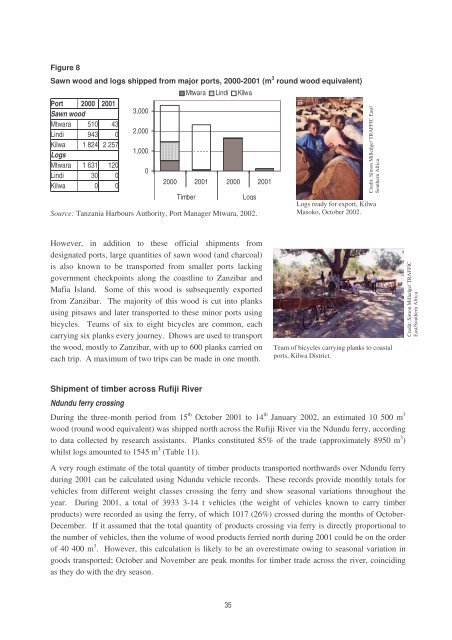Bridging the Gap: linking timber trade with infrastructural ...
Bridging the Gap: linking timber trade with infrastructural ...
Bridging the Gap: linking timber trade with infrastructural ...
Create successful ePaper yourself
Turn your PDF publications into a flip-book with our unique Google optimized e-Paper software.
Figure 8<br />
Sawn wood and logs shipped from major ports, 2000-2001 (m 3 round wood equivalent)<br />
Port 2000 2001<br />
Sawn wood<br />
Mtwara 510 43<br />
Lindi 943 0<br />
Kilwa 1 824 2 257<br />
Logs<br />
Mtwara 1 631 120<br />
Lindi 30 0<br />
Kilwa 0 0<br />
3,000<br />
2,000<br />
1,000<br />
0<br />
Mtwara Lindi Kilwa<br />
2000 2001 2000 2001<br />
Timber<br />
Logs<br />
Source: Tanzania Harbours Authority, Port Manager Mtwara, 2002.<br />
Credit: Simon Milledge/ TRAFFIC East/<br />
Sou<strong>the</strong>rn Africa<br />
Logs ready for export, Kilwa<br />
Masoko, October 2002.<br />
However, in addition to <strong>the</strong>se official shipments from<br />
designated ports, large quantities of sawn wood (and charcoal)<br />
is also known to be transported from smaller ports lacking<br />
government checkpoints along <strong>the</strong> coastline to Zanzibar and<br />
Mafia Island. Some of this wood is subsequently exported<br />
from Zanzibar. The majority of this wood is cut into planks<br />
using pitsaws and later transported to <strong>the</strong>se minor ports using<br />
bicycles. Teams of six to eight bicycles are common, each<br />
carrying six planks every journey. Dhows are used to transport<br />
<strong>the</strong> wood, mostly to Zanzibar, <strong>with</strong> up to 600 planks carried on<br />
each trip. A maximum of two trips can be made in one month.<br />
Team of bicycles carrying planks to coastal<br />
ports, Kilwa District.<br />
Credit: Simon Milledge/ TRAFFIC<br />
East/Sou<strong>the</strong>rn Africa<br />
Shipment of <strong>timber</strong> across Rufiji River<br />
Ndundu ferry crossing<br />
During <strong>the</strong> three-month period from 15 th October 2001 to 14 th January 2002, an estimated 10 500 m 3<br />
wood (round wood equivalent) was shipped north across <strong>the</strong> Rufiji River via <strong>the</strong> Ndundu ferry, according<br />
to data collected by research assistants. Planks constituted 85% of <strong>the</strong> <strong>trade</strong> (approximately 8950 m 3 )<br />
whilst logs amounted to 1545 m 3 (Table 11).<br />
A very rough estimate of <strong>the</strong> total quantity of <strong>timber</strong> products transported northwards over Ndundu ferry<br />
during 2001 can be calculated using Ndundu vehicle records. These records provide monthly totals for<br />
vehicles from different weight classes crossing <strong>the</strong> ferry and show seasonal variations throughout <strong>the</strong><br />
year. During 2001, a total of 3933 3-14 t vehicles (<strong>the</strong> weight of vehicles known to carry <strong>timber</strong><br />
products) were recorded as using <strong>the</strong> ferry, of which 1017 (26%) crossed during <strong>the</strong> months of October-<br />
December. If it assumed that <strong>the</strong> total quantity of products crossing via ferry is directly proportional to<br />
<strong>the</strong> number of vehicles, <strong>the</strong>n <strong>the</strong> volume of wood products ferried north during 2001 could be on <strong>the</strong> order<br />
of 40 400 m 3 . However, this calculation is likely to be an overestimate owing to seasonal variation in<br />
goods transported; October and November are peak months for <strong>timber</strong> <strong>trade</strong> across <strong>the</strong> river, coinciding<br />
as <strong>the</strong>y do <strong>with</strong> <strong>the</strong> dry season.<br />
35
















